The “Al-Tabi’in” Massacre: Exposing the Truth Behind Military Propaganda
By: Fatima Alkhatib
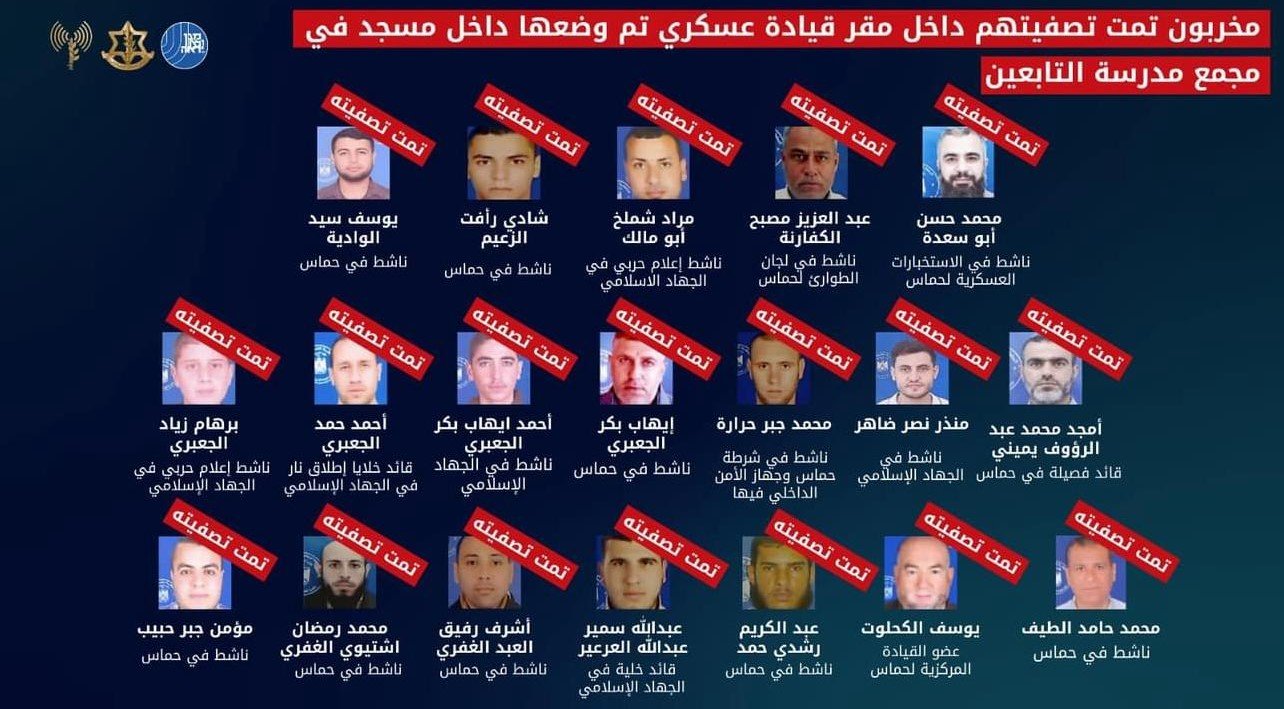
On the morning of Saturday, August 10th, the Israeli occupation launched an airstrike targeting “Al-Tabi’in” School and the mosque within its premises in the Al-Daraj neighborhood, located in the heart of Gaza City. The strike resulted in the deaths of over 100 individuals and left dozens more injured, as reported by the Government Media Office in Gaza.
Following the airstrike, the Israeli army issued a statement claiming that the operation targeted “terrorists” who were using the mosque within the “Al-Tabi’in” School complex as a military base for planning and executing attacks against Israeli soldiers in Gaza.
The massacre sparked international reactions, including a statement from the White House on Saturday, August 10th, expressing “deep concern” over the Israeli strike on “Al-Tabi’in” School. National Security Council spokesman Sean Savett said in a statement, “We are deeply concerned about reports of civilian casualties in Gaza,” adding that the United States “has requested more details.” Meanwhile, foreign ministers from several Arab countries, including Egypt, Qatar, Iraq, and Jordan, condemned the Israeli massacre of civilians at the “Al-Tabi’in” School, calling on the international community to take all necessary measures to stop Israel’s actions in the Gaza Strip.
Additionally, Turkey and Iran denounced the incident, stating that Israel had committed a crime against humanity with the intent of killing civilian worshippers.
In response, Nabil Abu Rudeineh, the official spokesman for the Palestinian presidency, held the U.S. administration accountable for the massacre “due to its financial, military, and political support for the occupation.” He emphasized that this was “a continuation of the daily massacres committed by the occupation in the Gaza Strip and the West Bank, which underline the occupation state’s intent to annihilate our people through collective massacres and daily killings, amidst a suspicious international silence.”
In this report, the Palestinian Observatory “Tahaqaq” examines the validity of the occupation’s claims regarding the motivations and circumstances behind the targeting of the school, which served as a refuge for displaced persons in Gaza City.
First: Refuting the Claims of the Israeli Army Spokesman Regarding the Targets of the “Al-Tabi’in” Massacre
Israeli army spokesman Avichay Adraee published a list of 19 individuals, claiming that they were targeted during the operation, alleging their affiliation with the “Hamas” and “Islamic Jihad” movements. He further asserted that the Israeli army and the “Shin Bet” targeted “terrorists” who were operating inside a military base located within a mosque at the “Al-Tabi’in” School complex in the Al-Daraj neighborhood.
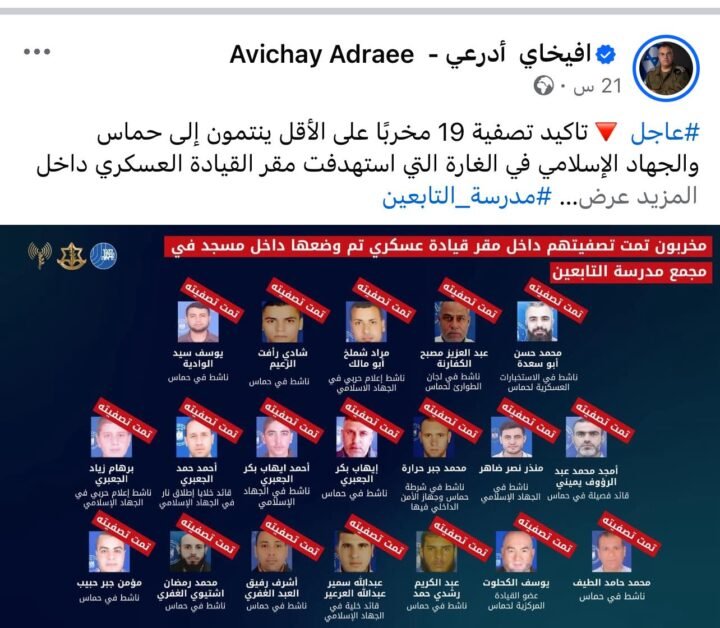
After researching in the public sources regarding the names listed in the document published by the Israeli army, it was revealed that the list includes names of martyrs who were killed days before the massacre. Among them is the martyr Youssef Said Al-Wadiya, who was confirmed to have been killed two days before the Al-Tabi’in Massacre, which definitively disproves his presence at the school.
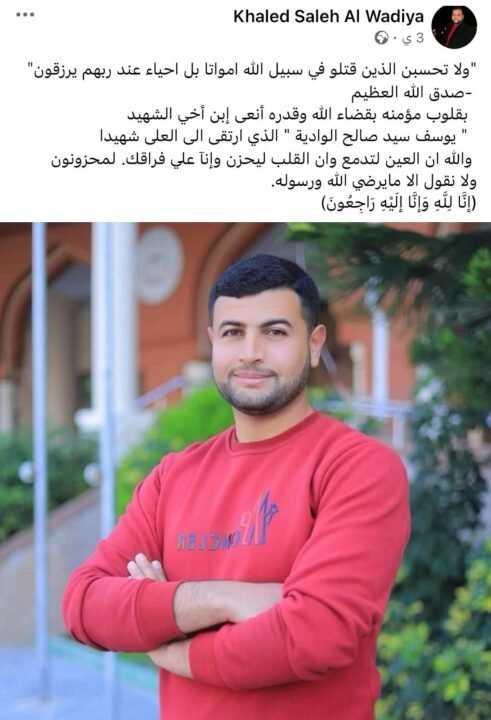
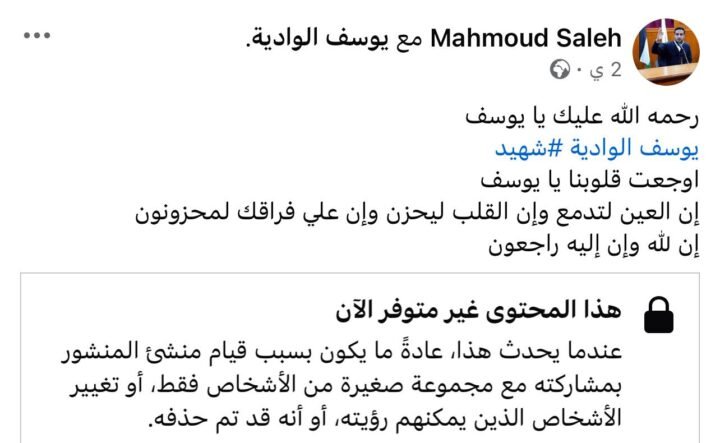
Munther Nasr Daher was also included among those allegedly targeted in the Al-Tabi’in School massacre. However, after investigation, it was found that the young man’s real name is Muntasir Nasr Daher, not Munther, and that he was killed a day before the massacre. Tahaqaq team reached sources close to the two martyrs (who requested anonymity out of fear of being targeted in Gaza) to clarify the circumstances of their deaths. One source explained that Muntasir was killed alongside his sister Na’ima on August 9th, when an airstrike hit their apartment across from the Public Service street, opposite the electricity company in central Gaza City.

Our source further revealed that Muntasir was an architect who owned a construction company and was around 30 years old. He had no ties to any political or partisan groups and was not involved in any military activities. Another family source told “Tahaqaq” that Youssef Al-Wadiya was killed two days before the massacre, in a different location and under different circumstances unrelated to the Al-Tabi’in massacre.
Rami Abdu, director of the Euro-Mediterranean Human Rights Monitor, confirmed these findings, stating: “Initial investigations have shown that the names released by the Israeli army are inaccurate. Upon review, it was discovered that among the 19 names listed by the Israeli military as terrorists killed in the Al-Tabi’in School massacre, 3 had actually been killed in earlier Israeli airstrikes. These include Ahmad Ihab Al-Jaabari, who was killed by the Israeli army on December 5, 2023; Youssef Al-Wadiya, who was targeted two days before the massacre; and Muntasir Daher, who died with his sister on Friday, August 9th, in their apartment—just one day before the massacre.
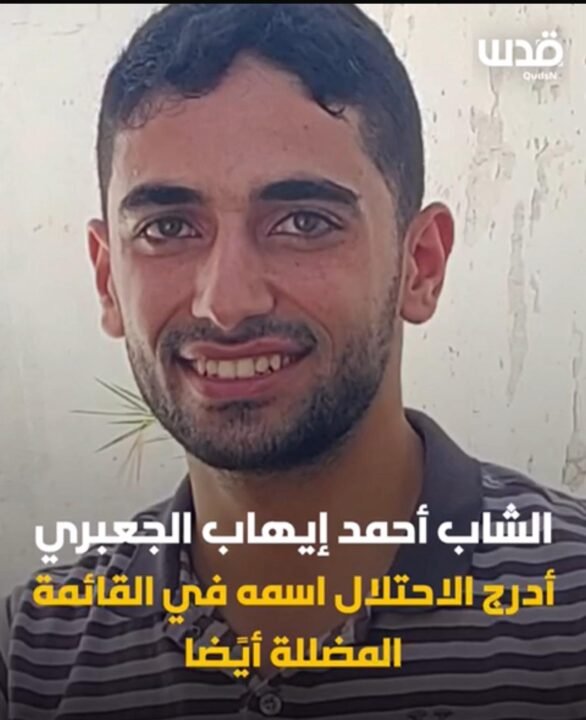
Abdu further told “Tahaqaq” that among the victims were three elderly civilians with no military affiliations: Mohamed Al-Taif, a former academic and school principal; Abdel Aziz Misbah Al-Kafarneh, the Deputy Mayor of Beit Hanoun; and Professor Youssef Khalout, an Arabic language professor at the Islamic University of Gaza. Additionally, 6 civilians were also killed, some of whom were critics of the “Hamas” movement.
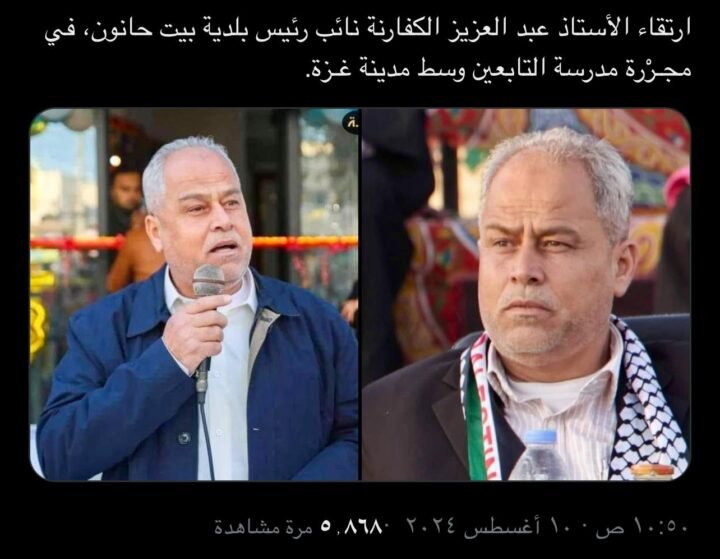

It was also revealed that among the martyrs was Sheikh Mohammad Hassan Abu Sa’da, the Director of Gaza’s Endowments. Several videos of him had been previously shared, showing him reciting verses from the Quran while leading prayers at a mosque in Gaza. In another video, he is seen reciting Quranic verses alongside other scholars.

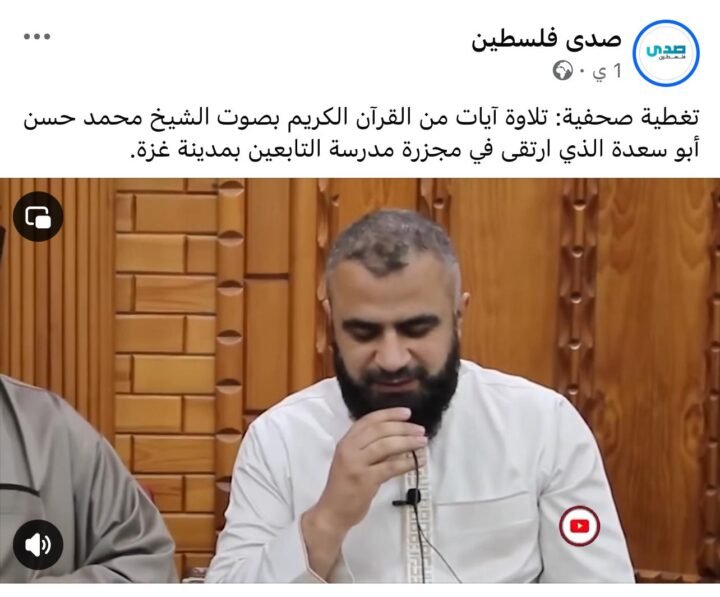
Meanwhile, journalists and activists published a photo of a message sent by Sheikh Mohammad the night before the massacre. In the message, he reminded the displaced people of the importance of attending a Quranic recitation session at the “Al-Tabi’in” Mosque at dawn on Saturday, August 10th—the morning of the massacre.
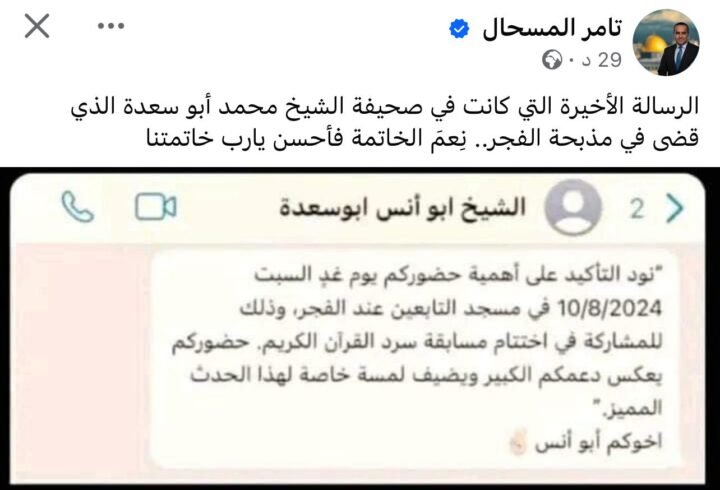
Second: Following the massacre, Ismail Al-Thawabta, the Director-General of the Government Media Office in Gaza, announced that the occupation forces directly targeted the displaced individuals while they were performing the dawn prayers, leading to a rapid increase in the number of casualties. He added that the scale of the massacre and the large number of victims hindered the medical, civil defense, and emergency response teams from retrieving the bodies promptly. Al-Thawabta noted that the school was struck by three missiles, each weighing 2,000 pounds of explosives. He emphasized that the Israeli army was aware of the displaced persons inside the school and described the Israeli army’s account of the incident as “Full of falsehoods and misinformation, aimed at using deceptive statements to justify its crimes against Palestinians”.
Israeli army spokesperson Avichay Adraee questioned the details provided in the government office’s reports regarding the extent of the damage and casualties from the massacre at the “Al-Tabi’in” School in the Al-Daraj neighborhood of Gaza City. Al-Thawabta, the Director-General of the Government Media Office, had stated that the attack involved three missiles, each with 2,000 pounds (907.184 kg) of explosives, and stressed that the Israeli army was aware of the displaced people in the school. However, Adraee challenged the specifics of the targeting operation reported by the Gaza government media, claiming that it involved three precision bombs, which, according to relevant authorities, are not capable of causing the level of destruction reported by the government media office in Gaza.
Adraee added that their data indicated that the attack didn’t result in significant damage to the targeted compound, as evidenced by images of the site post-strike. He also mentioned that several precautionary measures were taken before the attack to minimize civilian harm, including the use of precision munitions with small warheads, aerial photography, and accurate intelligence gathering.
Adraee’s statements contradict the reports from journalists and testimonies from survivors of the massacre. Journalist Islam Bader published a video of the moments immediately after the massacre, depicting the extent of the destruction. In the video, Bad describes the scene: “The bodies are torn apart, pools of blood everywhere… I can’t advance further to avoid stepping on the remains”, before a medic informs him that he is standing on pieces of the martyrs’ bodies, as clearly shown in the video.
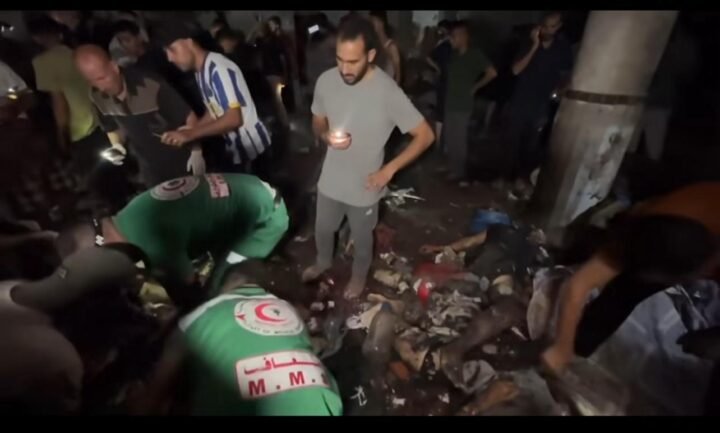
The following day, journalists documented the aftermath of the massacre, capturing evidence and remnants of the attack. Videos and photos revealed the scattered remains of worshippers and blood smeared on the walls of the site, a testament to the intensity of the explosion.
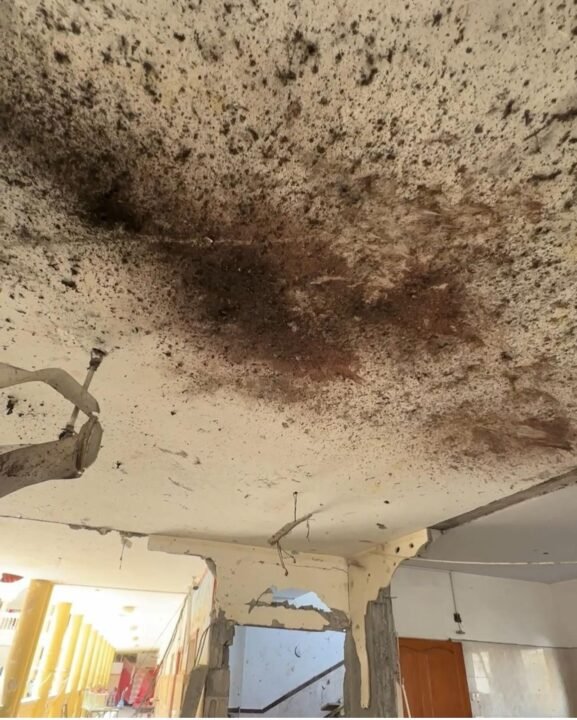
In other images from a video shared by journalist Islam Badir, the entrance of one of the missiles that struck the school is visible, while the other missiles were directed from the secondary entrances.
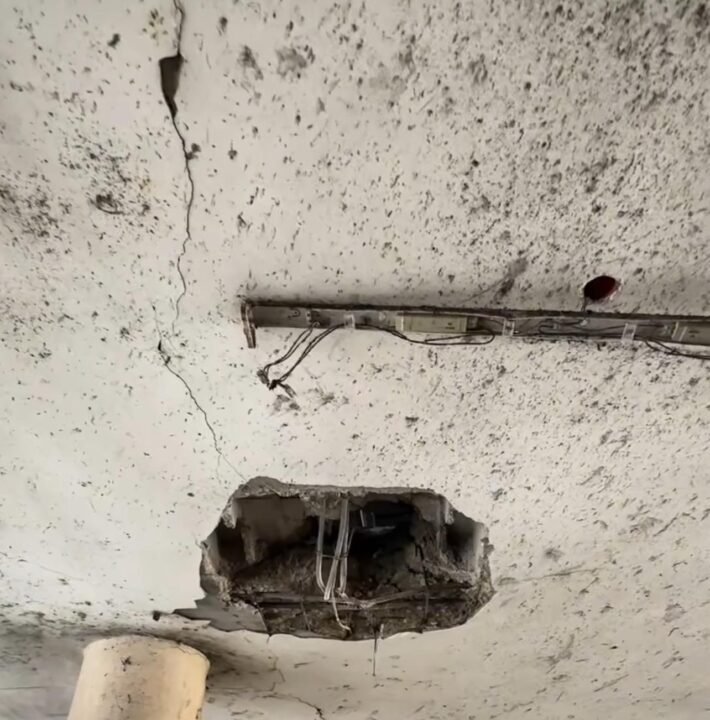
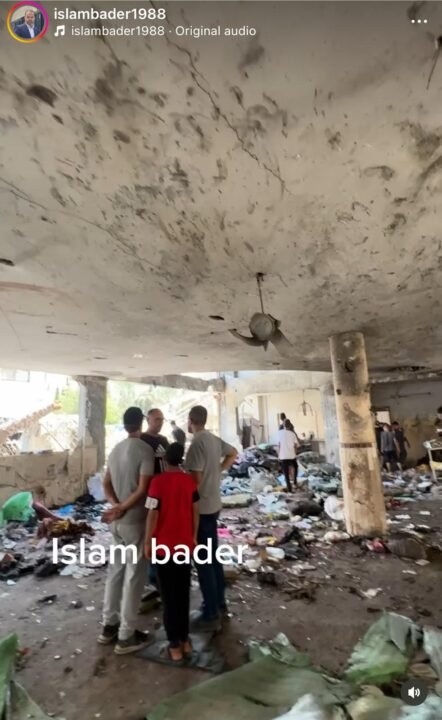
In another report by Al Jazeera correspondent Anas Al-Sharif, the extent of the devastation, the remains of the martyrs, and the personal belongings of the worshippers were documented, showing what was found the day after the massacre.

The Euro-Mediterranean Human Rights Monitor stated that its field and legal team conducted an initial survey and investigation at the Al-Tabi’in School, which was sheltering over 2,500 displaced people in Gaza City. The investigation included data collection, documentation of survivors’ and witnesses’ testimonies, and an on-site examination after the attack. All evidence and testimonies indicated that the school was free of any military gatherings or centers and was not used for any military purposes. The school housed hundreds of children whose families trusted their safety within its walls, according to survivor accounts.
Additionally, the characteristics of the site support the impossibility of its use for military purposes. The school consisted of narrow buildings without the necessary infrastructure for military operations, such as bunkers or launch points. The building featured cramped spaces and small rooms unsuitable for military activities requiring organization and logistical support. Testimonies collected from displaced civilians also indicated the absence of any military activities or equipment in the school; rather, it served as an emergency shelter for civilians fleeing destroyed areas. These factors make it implausible for the site to have had any military role or to have been used for military purposes, rendering the attack on this school unjustifiable and a severe violation of international humanitarian law.
The report further noted that the Israeli bombardment directly targeted displaced individuals during their dawn prayers in the school’s prayer hall, including the upper section designated for women and children. Preliminary information suggests that the Israeli army launched three American-made cruise missiles with immense destructive power capable of incinerating and dismembering bodies, resulting in more than 100 fatalities. The report highlighted that the missiles caused the bodies of the victims to be shredded and burned, with numerous severe injuries due to the missiles’ colossal destructive force. According to the Palestinian Civil Defense in Gaza, some of the bombs used against the crowded school weighed around 2,000 pounds.
The report criticized the Israeli army’s justification of the massacre by claiming it targeted a military site, stating that this explanation is unsubstantiated and does not justify the killing of such a large number of civilians. It emphasized that Israel cannot continue to kill, burn, and injure hundreds of civilians daily while claiming military objectives in targeted locations without providing genuine evidence or allowing independent international bodies to verify the validity of such claims.
Survivors of the massacre provide their testimonies
The newspaper “Al-Quds Al-Arabi” documented testimonies from displaced individuals who witnessed the details of the massacre. One survivor, named Youssef Al-Najjar, recounted: “We woke up to the sound of an airstrike followed by two massive explosions. I went down to the site and was shocked by the sight of the martyrs”. He added, “The intensity of the bombardment caused some of the bodies to be scattered into the street—remains of both adults and children. We found the bodies of children lying in the street”.
In another testimony recorded by TRT Arabic, a survivor described seeing the remains and parts of the martyrs’ bodies, while another survivor said, “We were standing praying when suddenly we saw smoke rising, along with fire and missiles”.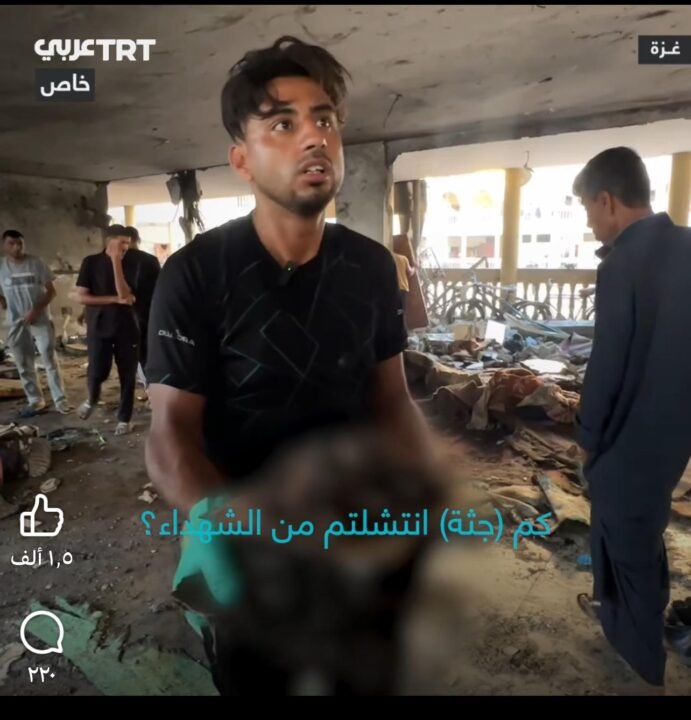
Susan Mohamed Al-Barawi, a displaced resident of the “Al-Tabi’in” School, told the Euro-Mediterranean Human Rights Monitor team: “We were sleeping when we woke up to the sound of explosions and fire. We rushed out of our classrooms to find flames engulfing the prayer hall. The women’s prayer hall at the Al-Tabi’in School is directly above the men’s prayer hall, and many families had sought refuge there after their homes were targeted. There were at least 20 families, including elderly women and children. The missiles hit, killing many, and those who survived either had their limbs severed or suffered severe burns. I saw injuries where intestines were exposed. Among the victims were young girls, the oldest being 13 years old, another 10 years old, and others as young as two years old”.
In a video of another survivor of the massacre, documented by Al Jazeera, she described how her son died while in prayer, with no signs of any military presence as claimed by the occupation forces.
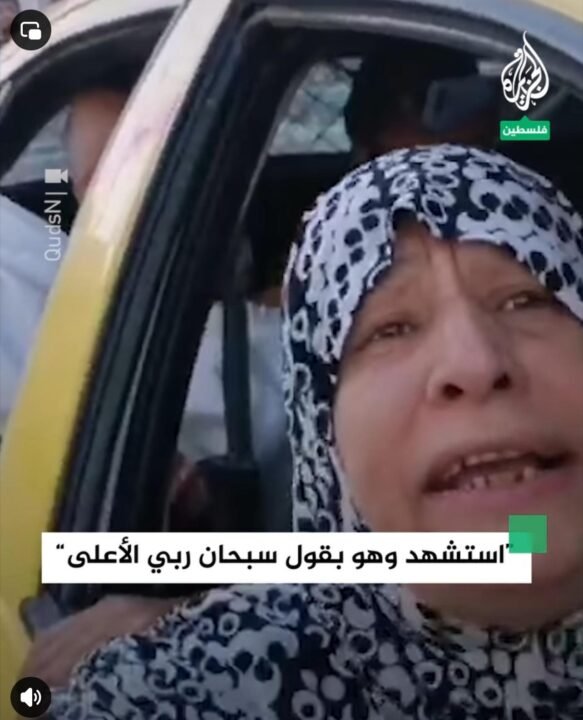
Palestinian Factions Deny Israeli Claims
“Hamas” issued a statement refuting the Israeli occupation’s claims about the presence of militants inside the Al-Tabi’in School. The movement asserted that the Israeli army is attempting to justify its crime amidst widespread international criticism by falsely and misleadingly alleging that 19 of the more than 100 civilians killed in the Al-Tabi’in School massacre were resistance activists.
“Hamas” emphasized that these claims are baseless and that the list of names includes children, civilian employees, university professors, and religious figures who have no connection to any political or military activities. The movement stressed that all the massacre’s victims were civilians, and none were militants, as they were targeted while performing their dawn prayers.
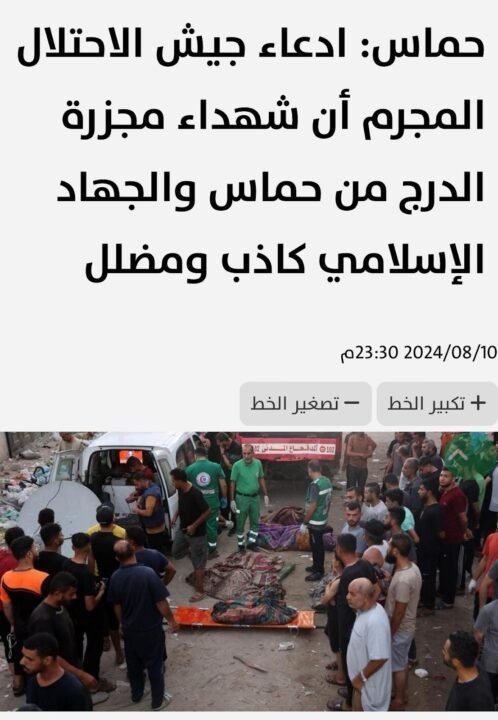
The “Islamic Jihad” Movement also categorically denied Israel’s claims of having militants from the movement inside the Al-Tabi’in School in the Al-Daraj neighborhood of Gaza City. The school was bombed by the Israeli army on Saturday, resulting in over 100 deaths and dozens of injuries.
This is Not the First Massacre Claiming Civilian Lives During the Gaza War
Since the initiation of “Operation Al-Aqsa Flood” on October 7, 2023, launched by Palestinian factions with an attack on Gaza border settlements, and the subsequent ongoing Israeli war, over 49,000 Palestinians have been reported dead or missing, with more than 92,000 injured, according to the latest statistics from the Palestinian Ministry of Health.
The Israeli occupation forces have committed numerous massacres against Palestinian civilians in Gaza, often followed by misleading and fabricated justifications aimed at evading responsibility. One such example is the massacre at the Baptist Hospital on October 17, 2023, where approximately 500 people were killed. The occupation initially claimed that the massacre resulted from a failed Palestinian rocket launch attributed to “Islamic Jihad,” but evidence gathered and refuted by “Tahaqaq”.
The issue extends beyond the Al-Mandani massacre. The Israeli occupation has made a series of claims against hospitals in Gaza to justify repeated attacks on them. For instance, on November 14, 2023, Israeli army spokesperson Daniel Hagari released a video showing the weekly shift schedule of hospital staff, alleging that these were the names of fighters “guarding Israeli prisoners” inside a basement of the Al-Rantisi Hospital in Gaza.
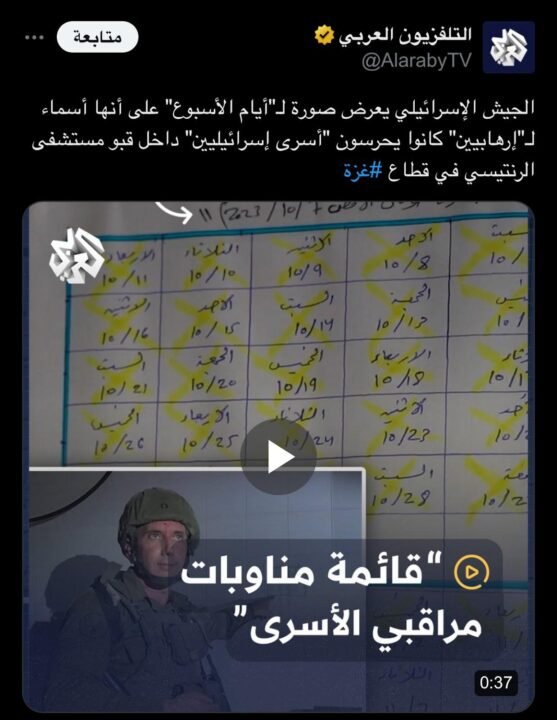
Misleading Narratives Accompany Repeated Attacks on Palestinian Civilians
On the morning of Thursday, February 29, 2024, the Israeli forces committed a massacre at the Nablusi Roundabout on Al-Rashid Street in Gaza, resulting in the deaths of over 104 Palestinians and injuring more than 700 others. The attack targeted a crowd of civilians who were waiting to receive humanitarian aid.
Initially, Israel didn’t acknowledge responsibility for the incident. However, it quickly began to distance itself from the event and propagated an alternative narrative, claiming that dozens of Palestinians who had stormed the aid trucks at a Gaza City intersection were killed due to stampeding and trampling. An Israeli official, who chose to remain unnamed, asserted that after the trucks moved northward, individuals approached the Israeli forces, prompting them to open fire and kill an unspecified number of people in what was described as a “limited” response, casting doubt on the casualty figures provided by the Palestinian Ministry of Health, as reported by Reuters.
The Israeli newspaper Haaretz published an initial army investigation, which attributed the massacre to two incidents. The first was a stampede among dozens of citizens, leading to deaths from trampling. The second incident involved armed individuals who allegedly obstructed the aid convoy at the Rimal neighborhood and looted its contents. According to this narrative, the approaching crowds near Israeli military units led the latter to fire warning shots into the air from a distance of 10 meters before targeting the lower extremities of those who continued advancing towards them. However, Israeli military spokesperson Daniel Hagari completely revised this account, flatly denying that soldiers fired at the aid convoy. Hagari claimed that thousands of Gazans attacked the trucks, with some violently pushing others and trampling them to death while looting the humanitarian supplies.
The Euro-Mediterranean Observatory vehemently rejected the Israeli account, indicating that preliminary investigations reveal that many victims were shot with live ammunition after Israeli tanks fired at them intensively. The Observatory highlighted four key pieces of evidence implicating the Israeli military in targeting starving civilians: firstly, injuries on the victims’ bodies and blood-stained flour sacks and aid boxes examined by one of the center’s researchers at Al-Shifa Hospital; secondly, video clips published by eyewitnesses that captured the sound of gunfire, confirmed by survivors as originating from Israeli tanks stationed towards the sea. Additionally, the Observatory analyzed the gunfire sound signature in the videos, determining it came from a 5.56mm assault rifle used by the Israeli army. Lastly, aerial footage released by the Israeli forces showed at least two tanks and bodies and injured individuals along their path, with no corpses visible along the route of the trucks.

